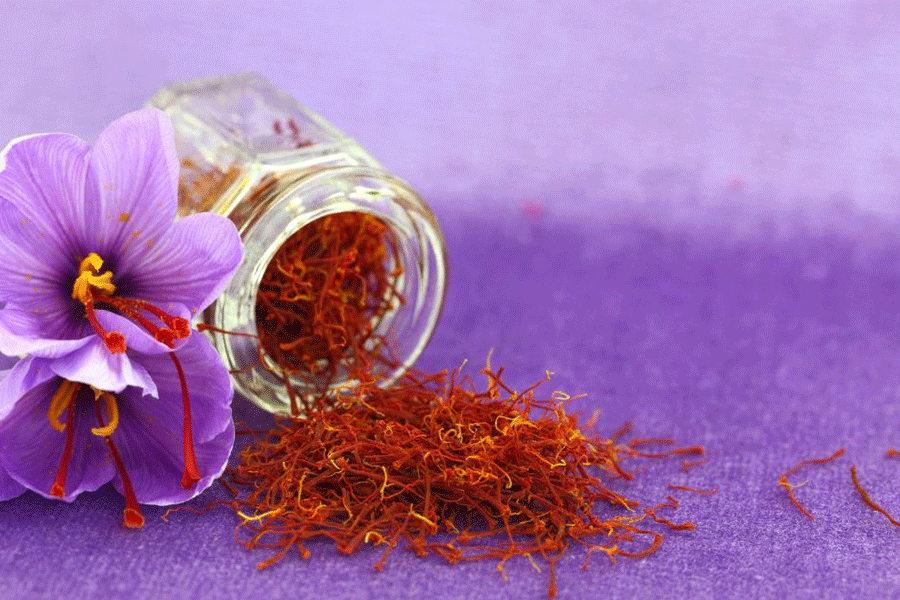
Selecting the Best Iranian Saffron Complete guide
Iranian saffron: The plant that produces saffron is scientifically known as Crocus Sativus. This delicate plant blooms just once a year and must be harvested by hand with great care. Saffron is often called “red gold” because of the immense effort required to produce it—each flower yields only three threads, which are carefully dried to create just one ounce of pure saffron.
Iranian saffron is celebrated as the finest in the world, with over 90% of global production coming from there. To ensure you’re getting genuine saffron, it’s important to be cautious and verify the source. While saffron is also produced in regions like Afghanistan, Kashmir, Spain, Greece, and Iran, the quality of Persian saffron is truly unparalleled.
Persian Saffron: What You Need to Know
In this article, you’ll find useful information about Iranian saffron, including its benefits, features, and how to tell real saffron from fake.
What Makes Iranian Saffron the Best?
Iranian saffron stands out for its exceptional quality. The Crocus Sativus, or Saffron Crocus, features six purple flowers and three vivid red stigmas from which the spice is derived. This intricate harvesting process makes it the most expensive spice in the world. Often called “red gold,” Iranian saffron is highly prized for its role in Persian cuisine, adding flavor and color to savory dishes, sweets, and even used in traditional remedies. Its high value has led to significant historical events, including a conflict in central Europe in 1374 due to its demand.
How Iranian Saffron is Used
Saffron is a cherished spice in Persian cuisine, known for its ability to add beautiful color and delightful aroma to dishes. Iranians use saffron in a variety of foods, including tea, kebabs, stews, and desserts. It’s especially popular in shole zard, a traditional Persian rice pudding often served at special events. Beyond cooking, saffron is also used to add color to handmade Persian rugs.
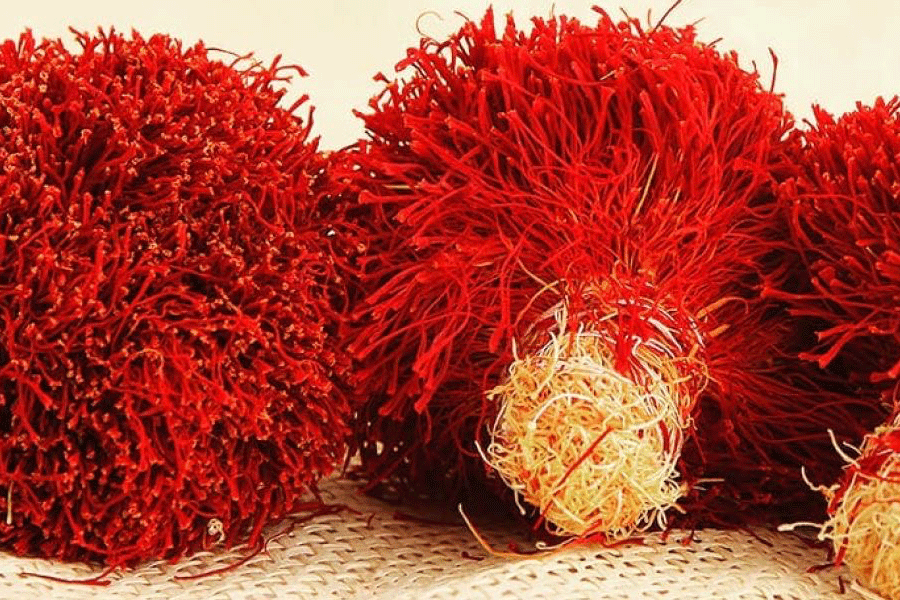
Benefits of Persian Saffron
Saffron’s origins are believed to trace back to Iran, where it was valued for its therapeutic properties. Historically, saffron was used to enhance libido, improve mood, and boost memory. Here are some notable health benefits of Iranian saffron:
1. Iranian Saffron: A Powerful Antioxidant
Saffron is rich in a variety of plant compounds with antioxidant properties that help protect your cells from damage caused by oxidative stress and free radicals. Key antioxidants in saffron include crocin, crocetin, safranal, and kaempferol. Crocin and crocetin, which give saffron its vibrant red color, may act as antidepressants, protect against brain damage, reduce inflammation, control appetite, and aid in weight loss. Safranal, known for its distinctive flavor and aroma, may enhance mood, memory, and learning while safeguarding brain cells from oxidative harm. Additionally, kaempferol, found in saffron petals, offers benefits such as reduced inflammation, anticancer properties, and mood-boosting effects.
2. Iranian Saffron May Help Reduce Depression Symptoms
Studies have shown that saffron supplements can be significantly more effective than placebos in alleviating mild to moderate depression. Research indicates that a daily dose of 30 mg of saffron can be as effective as traditional antidepressants like Fluoxetine, Citalopram, and Imipramine, with fewer side effects. Both the saffron petals and its thread-like stigma have shown promise in treating depression. While these findings are promising, further research with larger groups is needed before saffron can be recommended as a treatment for depression.
3. Iranian Saffron May Support the Body in Fighting Cancer
Saffron is rich in antioxidants, which help neutralize harmful free radicals linked to chronic diseases like cancer. Laboratory studies have shown that saffron and its components can selectively target and inhibit the growth of colon cancer cells while leaving healthy cells unharmed. This effect has also been observed in cancer cells from the bone marrow, breast, cervix, prostate, lung, and other organs. Additionally, crocin, a key antioxidant in saffron, may enhance the effectiveness of chemotherapy drugs against cancer cells. While these lab results are promising, more research is needed to fully understand saffron’s potential anticancer benefits in humans.
4. Iranian Saffron May Help Ease PMS Symptoms
Research suggests that saffron can help alleviate symptoms of PMS. Women aged 20 to 45 who took a daily dose of 30 mg of saffron experienced greater relief from symptoms like irritability, headaches, food cravings, and discomfort compared to those who took a placebo. Additionally, inhaling saffron for just 20 minutes was found to significantly reduce PMS symptoms, including anxiety and levels of the stress hormone cortisol.
5. Iranian Saffron May Aid in Weight Loss
Frequent snacking can contribute to weight gain, but research suggests that saffron may help curb your appetite. In an 8-week study, women who took saffron supplements experienced greater weight loss and felt fuller, leading to reduced snacking compared to those taking a placebo. Saffron also significantly decreased appetite, body mass index, waist circumference, and overall fat mass. Although the exact mechanism by which saffron aids weight loss is not fully understood, it is believed that saffron may improve mood, which could reduce the desire to eat.
Other Potential Health Benefits of Iranian Saffron
Saffron may offer several additional health benefits, although these are not yet fully proven. It could help reduce heart disease risk by lowering blood cholesterol and preventing artery blockages, thanks to its antioxidant properties observed in animal and lab studies. Saffron might also help manage blood sugar levels by increasing insulin sensitivity and reducing blood sugar, as seen in tests with diabetic mice. For those with age-related macular degeneration (AMD), saffron may protect against free radical damage and improve vision. Additionally, saffron’s antioxidants could potentially enhance memory and cognitive function in individuals with Alzheimer’s disease.
Risks and Dosage of Iranian Saffron
Saffron generally has few side effects when used in normal cooking amounts. It is safe to consume up to 1.5 grams of saffron daily as a dietary supplement, with just 30 mg per day often being enough to enjoy its health benefits. However, taking high doses of 5 grams or more can be dangerous and may lead to negative effects. Pregnant women should avoid high doses, as they could risk miscarriage. As with any supplement, it’s best to consult a healthcare professional before starting saffron.
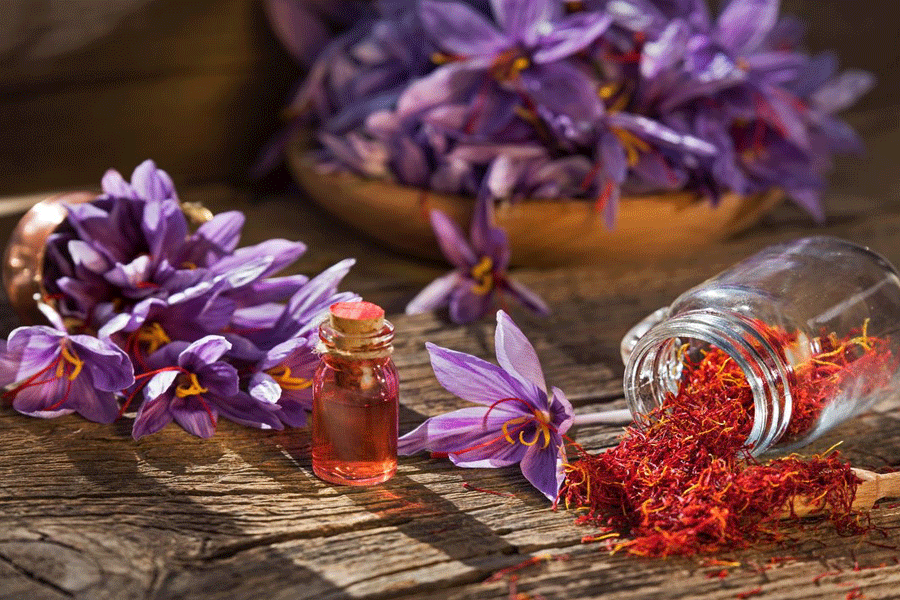
Iranian Saffron Harvest Season
Saffron thrives in regions with significant temperature swings between day and night, making the provinces of Razavi Khorasan and South Khorasan in Iran ideal for its cultivation. The saffron harvest season is brief, typically lasting just a few weeks from around November 1st. The process begins when the purple saffron flowers start to bloom in the fields of eastern Iran’s Fars Province. Farmers arrive before dawn to begin the meticulous task of hand-picking the blossoms. The delicate stigmas are carefully separated and stored in a sheltered area. November is a popular time for visitors to experience the fascinating saffron harvest and even assist farmers in this unique process.
Types of Iranian Saffron
Iranian saffron is categorized into four main types, found both within Iran and internationally:
Super Negin Saffron: This is the highest grade of Iranian saffron, known for its large, pure red threads. Super Negin saffron is prized for its exceptional quality and rich flavor.
Negin Saffron: This variety is the second-highest grade of Iranian saffron. Negin saffron is made from the most vibrant and delicate red parts of the saffron flower, offering excellent quality.
Sargol Saffron: Known as “sargol,” which translates to “top of the flower,” this type of saffron includes only red threads, though they are shorter compared to Negin and Super Negin saffron.
Pushal Saffron: Pushal saffron features a mix of mostly red threads with a few yellow ones. The yellow threads have changed color during the drying process but are still perfectly usable.
Iranian Saffron Pricing
As one of the most expensive spices globally, saffron’s high cost is largely due to the labor-intensive process required to produce it. It takes about 150,000–200,000 saffron flowers to yield just 1 kilogram of dried saffron. In 2022, the price of 1 kilogram of Iranian saffron ranged from approximately $315.32 to $1,254.03. However, saffron is significantly cheaper in Iran due to the abundant supply in the market. Additionally, the large harvests and lower labor costs in Iran contribute to its more affordable pricing compared to saffron from other countries.
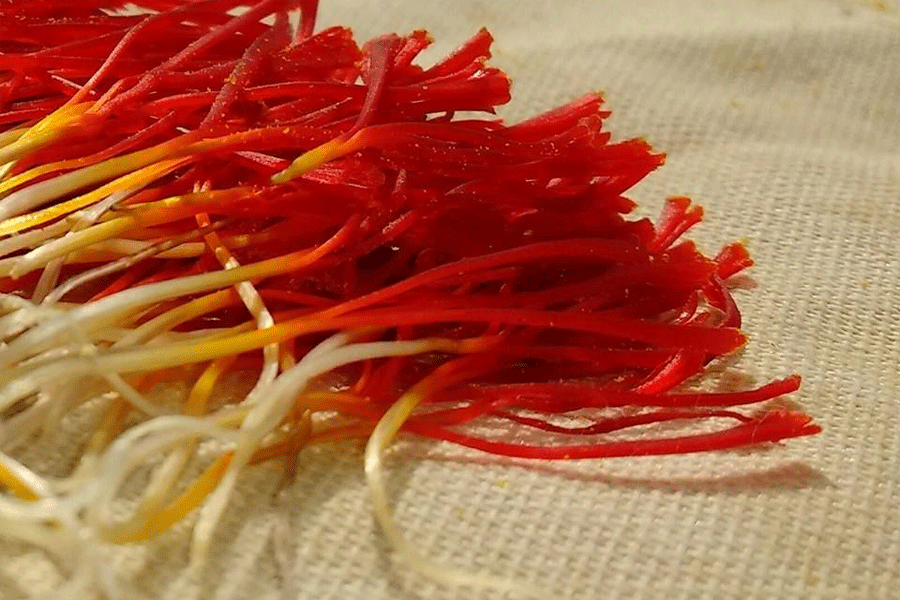
Which Country Produces the Best Saffron: Iran, Spain, or India?
As mentioned earlier, Iranian saffron is widely considered the finest in the world. Iran produces nearly 95% of the global saffron supply, selling over 300 tons annually. This makes Iran the largest producer and exporter of saffron, with exports reaching 40 countries, including Spain, China, India, Hong Kong, Italy, and the UAE. Interestingly, some countries repackage Iranian saffron under their own brands for export. Spanish and Kashmiri saffron are the primary competitors to Iranian saffron. Below, we’ll compare Iranian saffron with both Kashmiri and Spanish varieties.
Iranian Saffron vs. Kashmiri Saffron
Both Iranian and Kashmiri saffron are highly valued for their quality, and distinguishing between the two can be challenging. Kashmiri saffron typically has slightly wider stigma heads, but both types offer rich color and aroma. Iranian farmers have centuries of experience in saffron cultivation, enabling them to produce large quantities while expertly managing challenges like drought and heavy rains. Iran produces between 80% and 95% of the world’s saffron, depending on the source.
Kashmiri saffron, however, has faced issues such as crop adulteration, harsh weather affecting quality, and even the smuggling of Iranian saffron into India, which can lead to inconsistencies in the final product. While both varieties are of similar quality, Iranian saffron is more affordable at the source. To protect its own market, India imposes high taxes on Iranian saffron to support the Kashmiri saffron industry.
Iranian Saffron vs. Spanish Saffron
The rich red or dark red color of saffron indicates a high crocin content, the natural pigment responsible for its coloring power. Compared to Iranian saffron, Spanish saffron is generally lighter and brighter, partly due to the labor-intensive production process in Spain, which results in less potent coloring properties. Persian saffron is known for its long, thick, and flat stigmas, whereas Spanish saffron tends to have shorter, curlier stigmas.
Spain produces about 1 ton of saffron annually, yet exports around 100 tons, much of which is repackaged Iranian saffron sold as “Spanish saffron.” In some cases, cheaper Spanish saffron is even mixed with imported Iranian saffron for export. When you purchase Iranian saffron, you’re ensuring that you’re getting pure, high-quality saffron directly from the source, where the majority of the world’s saffron is cultivated.
Despite the premium quality, Iranian saffron remains competitively priced compared to Spanish, Kashmiri, and Italian varieties. While Kashmiri saffron is delicate, Iranian saffron offers the same quality without the associated challenges.
Does Iranian Saffron Expire?
Saffron doesn’t technically expire, but it does have a shelf life. Over time, if not stored properly, saffron can lose its strong flavor and aroma. To preserve its quality, store saffron in an airtight container in a cool, dark place, and use it within six months for the best taste. Since saffron is sensitive to light, wrapping the container in foil can provide extra protection. While saffron won’t spoil, its flavor will gradually diminish as it ages.
Is Iranian Saffron Available in the USA?
While saffron is grown in the U.S., most of it is imported from regions like Kashmir, Afghanistan, and Iran, where saffron is a culinary staple and labor costs are lower. Iran is the largest producer of saffron globally, but due to economic sanctions, direct purchase from Iranian companies is restricted in the U.S. However, you can still buy Iranian saffron through intermediaries, Iranian restaurants, and specialty shops in the U.S., or by purchasing online from platforms like Amazon, where reputable Iranian saffron brands are available.
How to Spot Fake Saffron
To identify genuine saffron, start by examining its appearance. Authentic saffron stigmas are trumpet-shaped at one end and gradually taper down. They also have a vibrant crimson color.
Another key way to distinguish real saffron from fake is by its flavor. True saffron should have a sweet aroma but not a sweet taste. Some sellers may add honey or sugar to saffron to increase its weight, but authentic saffron will have a slightly bitter taste. You can place a strand on your tongue to check for this subtle bitterness.
Lastly, use your sense of smell. Real saffron has a distinct fragrance, a blend of honey and hay. Knowing this scent will help you differentiate it from fake saffron.
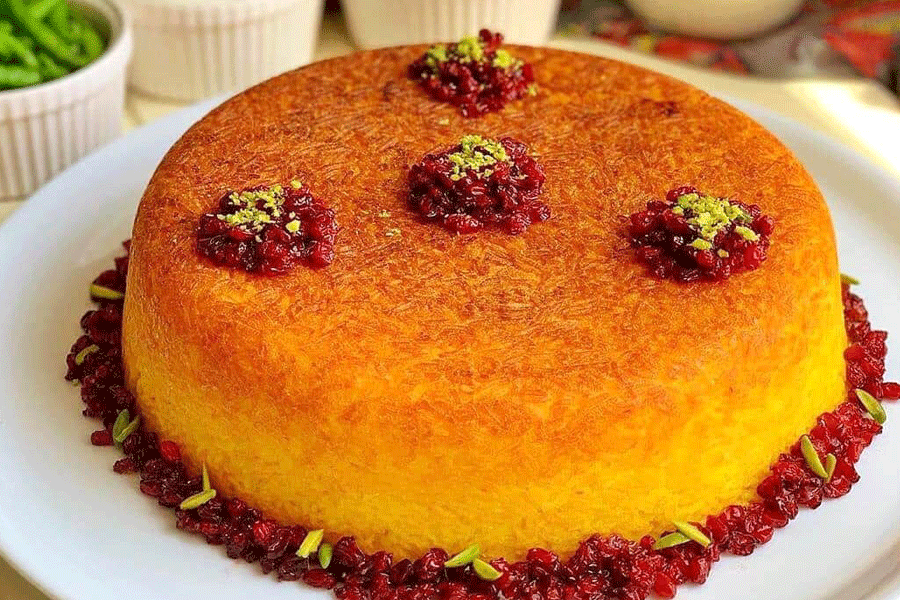
How to Verify Genuine Iranian Saffron
To test the authenticity of your saffron, you can use two simple methods:
1. Color Test with Water: Run a small amount of saffron under warm water. Genuine saffron will retain its vibrant red color, while fake saffron will lose its hue and appear lighter.
2. Heat Test: Hold a small amount of saffron near a stove flame. Authentic saffron will change color to orange or purple, whereas fake saffron will turn yellow.
These straightforward tests can help you determine if your saffron is genuine.
Iranian Saffron Summary
Iran is the birthplace of saffron, producing over 90% of the world’s supply each year. Persian saffron stands out for its deep color and distinctive, tingling aroma, setting it apart from saffron grown in other countries. It has long been a vital element in Persian cuisine and culture, and genuine Iranian saffron is highly regarded for its exceptional quality. The saffron from Khorasan Razavi, in particular, is celebrated for its superior attributes.
This article provides key insights into the benefits of Iranian saffron, its pricing, harvesting methods, and how to identify authentic saffron from imitations. We hope you found this information useful. Share your thoughts on Iranian saffron in the comments below!

